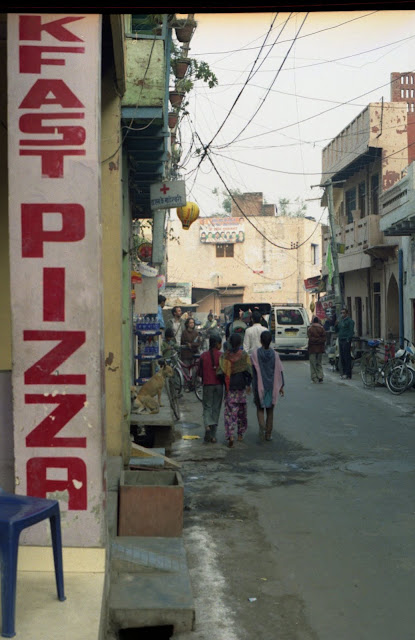As tourist activities go, I'm sure there are nicer places to be visiting, parks, museums, galleries; all three commonplace in any city. It is possible however to find all three in one unique place; part greenery, part weird social museum, a gallery of a kind...a quiet spot really. It's sick I know, but I rather like visiting graveyards.
Is it normal to want to spend the afternoon with a bunch of dead people you have no familial or friendly link to? Who knows? I do know that these domains of eternal rest, especially of the foreign variety hold a basic allure.
Here in Kolkata, the creme de la creme of ghoul-yards is the cemetery at Park St. This is in itself an unusual place aside from all I have written above. The Hindu's cremate and the Parsi lay theirs out in ivory towers for the vultures to pick clean. The Muslim's bury but this is not a resting place for the city's Muslim communities. Rather this haven of slumber is home to a glitterati stretching back into the late 18th century. This is where the British Raj's human remains rest.
The cemetery lies on the far eastern end corner of Park St at the junction with the frenetic AJC Bose Rd. Originally situated on the border of a large murky bog, Park St itself evolved to it's current manifestation from an original pathway across the mire allowing the living to safely transport the dead without getting dead themselves.
Kolkata's raging August heat has put the kybosh on quite a few of our planned excursions but walking through the high outer gates and into the main avenue, a coolness clams down on our beading foreheads. It's like wandering into a cool exotic greenhouse. The wide avenues are marked out with edging slabs and darkened sand. It has recently thrown down a vicious shower of rain and the jungular canopy of palm and bamboo has trapped the wet creating a delicious breeze as the wind rolls through.
The avenues are kept in an admirably overgrown state, in between the tombs the grass is just about kept in hand. The traffic noise quietens to a distant drone behind the high pastel blue outer walls and is superceded by the surround sound squeak of a thousand crickets, mozzies and midge.
The manner in which differing cultures honour their dead has always been of interest to me. Amongst these ex-pats, with the blood and hellfire of rampant imperialism coursing through their vessels, bigger was certainly better. The tombs are a grim ode to conspicuous consumption, all around there are colossus' of mourning; loss spelt out in 20 foot sandstone.
One celebrated beauty from the 18th century, a Miss Elizabeth Anderson, a lady who 'broke the hearts of all the gentlemen she encountered' has a tomb fit for 50! A vast stone pyramid resting in a secluded corner. She journeyed to India in the late 1790's and pegged it two years later at the ripe old age of 23.
She and other famous residents have had a nip and tuck job done on their tombs, their plaques bear freshly cleaved out inscriptions. Other not so celebrated residents dwell in decay; plaques eroded to a point where ownership is impossible to tell. The not so humble plots of peace are a weird and wonderful cornucopia of design. Hexagonal pillared mausoleia to Greco-style collanaded houses, pyramids to gothic cream marble columns reaching skywards. Distasteful as it all is, it really could be plucked whole from a fairytale.
The plaques themselves tell a great deal about their owners and the exclusive circles they lived in. Their graves offer a brief but insightful peek into their lives and those of the wider British elite resident in India at that time. The inscriptions still legible have a formulaic poetic style. Note the accepted wording of the time. Ladies were 'Loved in life, long lamented in death', 'the best of wives, mothers and friends' as well as naturally being a 'goodly christian woman'. This last tribute is particularly interesting given the ladies attitude towards ‘the natives’.
The average life span was a short one, the cause of death is not given but on the whole few made it past their 20's. The women in particular died young, many died shortly after arriving in the country. This is perhaps no surprise given the frequent outbreaks of cholera and malaria on the subcontinent; both classic Raj purgers, childbirth and then the old demon; TB.
It's a strange place, exotic and if taken at face value, rather lovely. It had also the added advantage of being the sole spot in Kolkata where you could find an elusive hour of peace! On the other hand it renders no better the already tarnished reputation of the Anglo-Indians. They come out of it as exclusive a sphere as ever well pleased with themselves and the little corner of England they managed to carve out.
In life these empire builders, looters, flagrant profiteers and eventual ruling classes demanded and lived in separation from those they ruled over. In death, walled up inside this pastel blue cocoon they have it still.

No comments:
Post a Comment